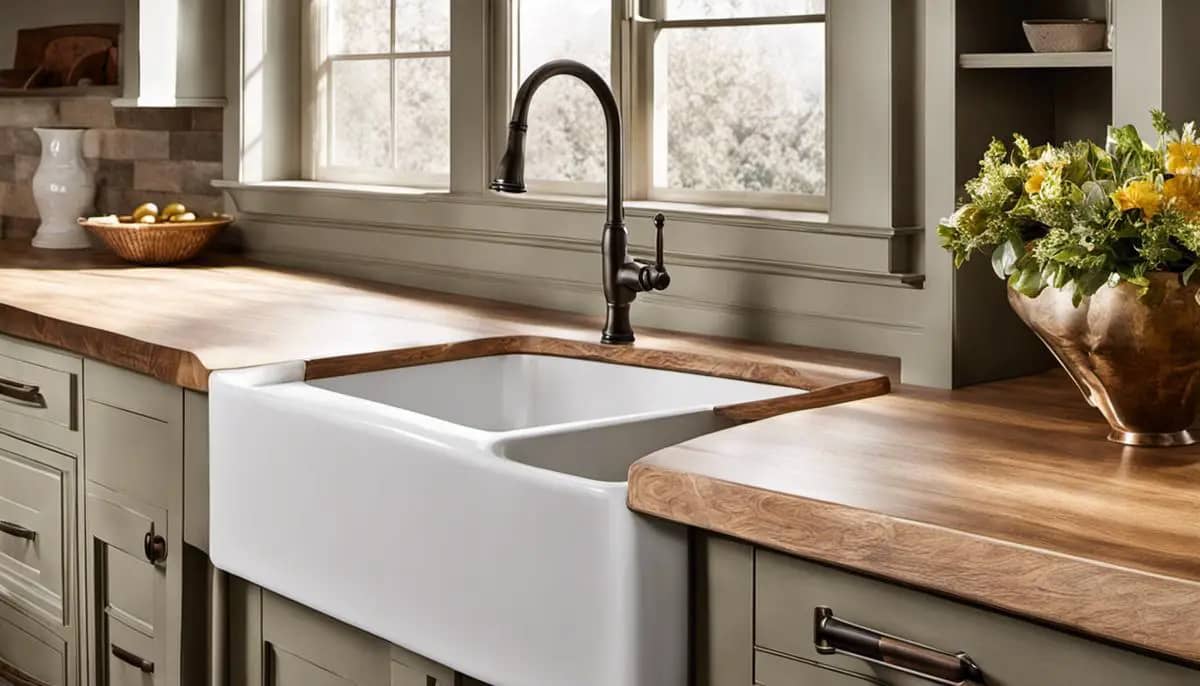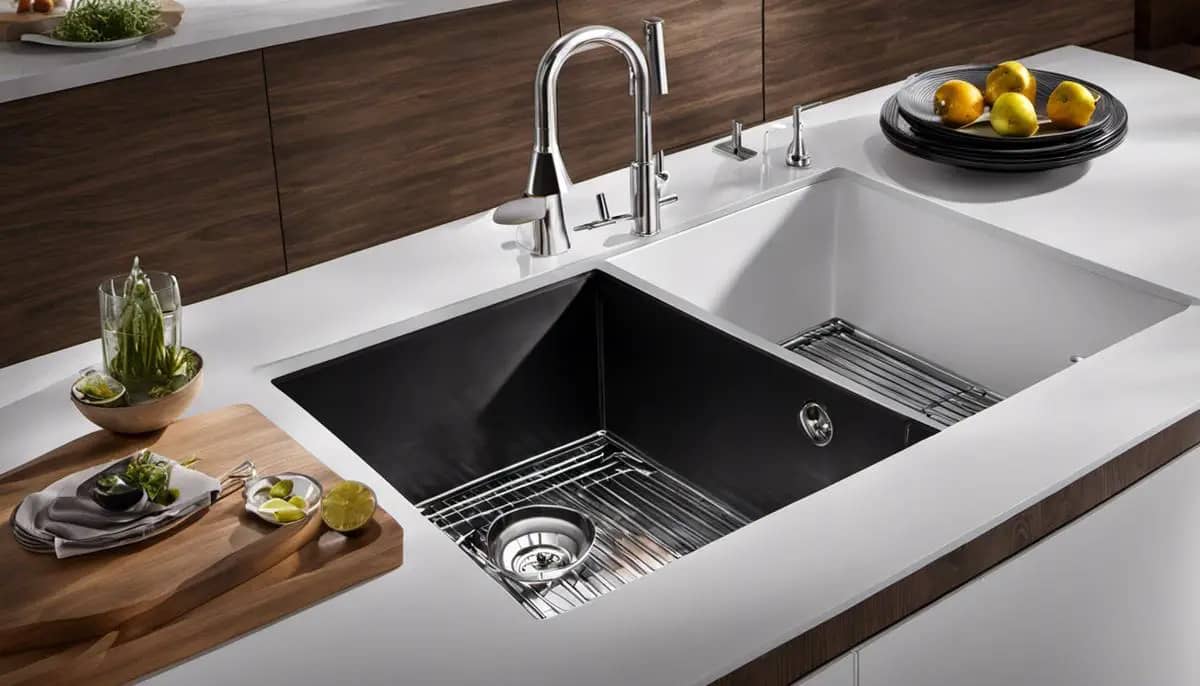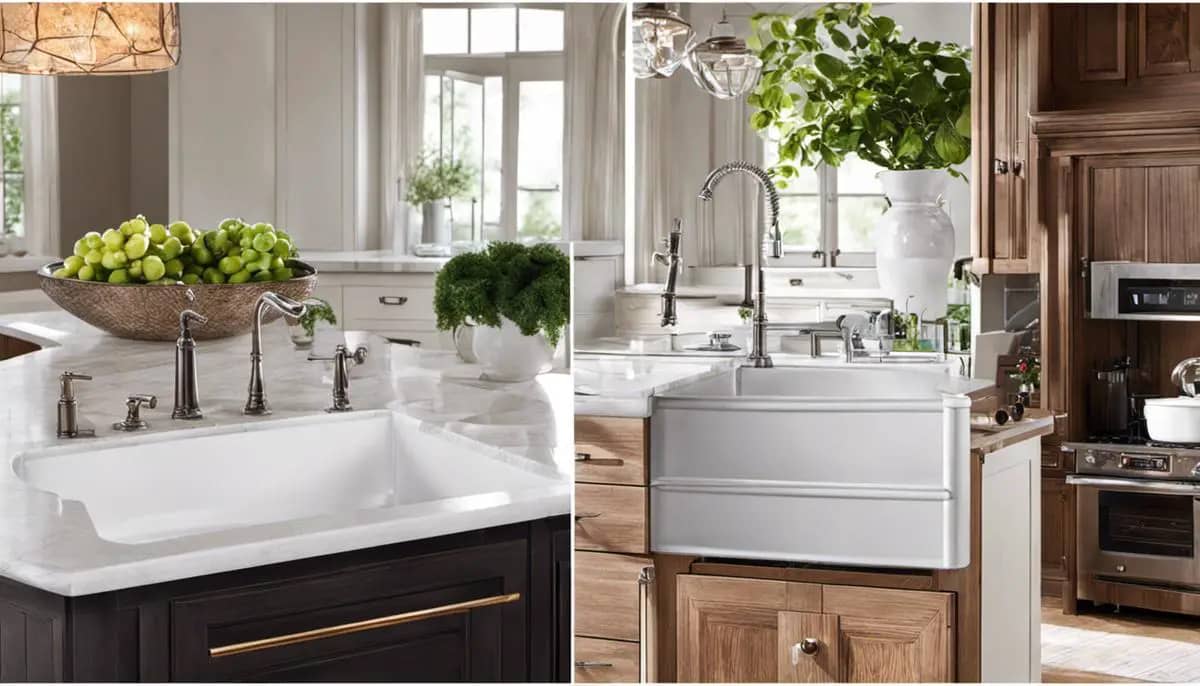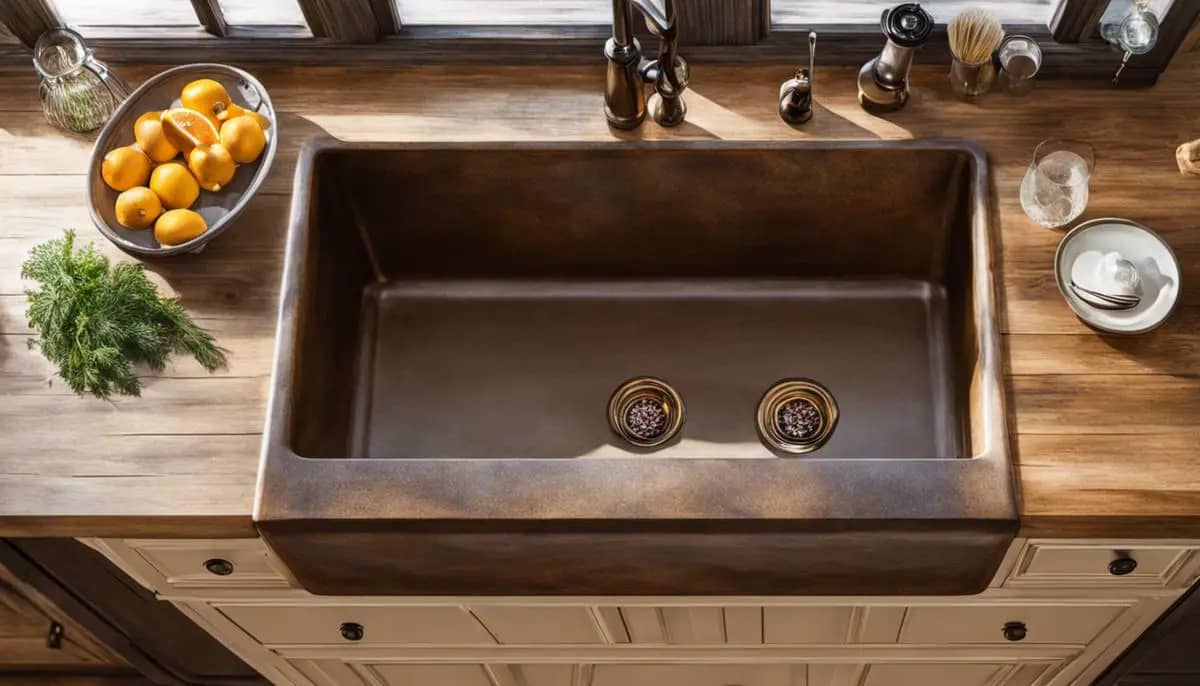As an Amazon Associate, I earn from qualifying purchases
In this blog post, we delve into the world of kitchen sink designs, focusing our comparison on two popular styles – Kitchen Sink Farmhouse vs Undermount sink.
When it comes to selecting the perfect sink for your kitchen, careful consideration is paramount, as your choice can significantly influence the functionality and aesthetic appeal of your space. The market offers a plethora of sink types, each with its unique features, benefits, and drawbacks. This article focuses predominantly on two popular kitchen sink types, farmhouse sinks and undermount sinks. Whether you are building a new kitchen from scratch or planning a kitchen renovation, getting a clear understanding and comparison of these two types can help make your sink selection process easier and smarter.
Understanding Kitchen Sinks
Why Kitchen Sinks Matter
Kitchen sinks play a crucial role in a home. Not just tools for cleaning dishes, they also add aesthetic value to the kitchen, affecting the overall look and feel of the space. High-end varieties can even increase the value of a home. The right sink can bring together a kitchen’s decor and serve as a critical component of the meal preparation and clean-up process. Therefore, choosing the right sink requires careful thought and consideration of several important factors.
Different Types of Kitchen Sinks: Farmhouse vs. Undermount
There are many types of kitchen sinks available, but two types that are often compared because of their popularity are farmhouse sinks and undermount sinks.
Farmhouse sinks, also known as apron-front sinks, have a distinctly classic appearance that originates from an era when running water was not readily available. The design of this type of sink is large and deep, making it easy to wash large pots and pans. The front of the sink extends out from the edge of the countertop, creating an apron-like appearance. Farmhouse sinks are usually single-basin, though two-basin varieties are available. They often require specialized installation due to their size and weight, which might increase the overall cost.
On the other hand, undermount sinks are installed beneath the countertop, creating a seamless look from countertop to sink. They are popular in contemporary kitchens due to their sleek, minimalistic design. Cleaning is easy with undermount sinks, as crumbs and water can be swept directly into the sink without any obstructions. They often come in single, double, and even triple basin styles. However, undermount sinks typically require solid surface countertops like granite or marble, as the edge of the countertop can be exposed to water.
Factors to Consider when Choosing a Kitchen Sink
When deciding on a kitchen sink, consider your daily needs, kitchen size, style preferences, and budget. For instance, if you cook often, you may prefer the large, deep basin of a farmhouse sink, which can accommodate large pots and pans. However, if you prefer a sleek, modern kitchen design, an undermount sink may be more suitable.
For budget considerations, the material of the sink is a key factor. Sinks can be made from a variety of materials including stainless steel, cast iron with enamel finish, composite materials, copper, and even stone. Stainless steel is often the most affordable option, while stone and copper can be on the higher end of the cost spectrum.
Installations costs should also be considered. Farmhouse sinks weigh more than traditional sink types and may require reinforcement of countertop and cabinetry, adding to the overall cost. Undermount sinks, while simpler to install, still require professional installation to ensure a waterproof seal and proper support.
As the kitchen sink is such a frequently used area in the house, it’s important to choose a style and material which appeals both in functionality and aesthetics. Appreciating the differences between farmhouse and undermount sinks can assist homeowners in making informed decisions that best fit their unique kitchen needs.
Understanding the Maintenance Needs of Farmhouse and Undermount Sinks
Whether you’ve chosen a farmhouse-style sink or an undermount sink, it’s essential to maintain it correctly to ensure its longevity. Irrespective of the type, both sinks should be cleaned gently using warm water, mild dish soap, and a soft cloth or sponge, and avoiding harsh cleaners that could damage their surface.
However, specific farmhouse sinks made from materials like fireclay or copper may require additional care as they are prone to developing patina or changing color over time. On the other hand, stainless steel undermount sinks, despite being robust, may display water spots and thus, could benefit from a specialized cleaner. Adhering to the manufacturer’s guidelines on care can help keep your sink in top shape while retaining its visual appeal for many years ahead.

Photo by bluewaterglobe on Unsplash
Detailed Overview of Farmhouse Sinks
Delving into the History of Farmhouse Sinks
Designed with a unique appeal and undeniable utility, farmhouse sinks, or apron-front sinks, were created in the late 17th century, stemming from the lack of running water in the countryside. Their spacious and deep basin catered to the diverse needs of large families that involved cooking, cleaning, and even laundering. Built with a distinctive design feature, the front section of these sinks was made to protrude purposely to safeguard the cabinets from potential water damage.
Key Features of Farmhouse Sinks
Farmhouse sinks differ from traditional sinks in several ways. Firstly, their size is significant; they are wider and deeper than standard sinks, allowing more room to wash large pots and pans. Most designs have a single basin, but there are also double basin options available. The signature feature of a farmhouse sink is its apron-front design. Unlike undermount sinks installed under the countertop level, the front-facing section of farmhouse sinks – the “apron” – is exposed and often intricately designed.
Benefits of Farmhouse Sinks
Farmhouse sinks have several advantages. They offer a larger workspace compared to traditional sinks due to their greater depth and width. This is especially helpful for those with large families or who often entertain guests. These sinks are also incredibly durable; farmhouse sinks are often made from cast iron or fireclay, which are known for their resistance to scratches, cracks, and stains. Additionally, their unique, vintage appearance can significantly enhance your kitchen decor, adding a touch of elegance and charm.
Drawbacks of Farmhouse Sinks
Despite their benefits, farmhouse sinks do come with a few drawbacks. Due to their size and material, they are usually more expensive than standard undermount sinks. The installation process can also be more challenging and costly; special cabinet modifications might be required to support the sink’s weight. It’s also worth noting that these sinks can be quite heavy, which may increase the risk of damage if not installed correctly. Finally, if the sink is made from cast iron or another material that isn’t stainless steel, it might require additional maintenance to keep it looking its best.
Key Considerations When Purchasing
When considering a farmhouse sink, buyers should look at several factors. Among them are the size of the sink, its construction material, the size of the kitchen, and the cabinet’s size and strength that will hold the sink. Depending on the material, some farmhouse sinks may require additional sealing or special cleaning to prevent discoloration or damage. It’s critical to thoroughly research and consider your specific needs, your kitchen’s size and layout, and the sink’s installation requirements before making a purchase.
Understanding the Installation and Maintenance of Farmhouse Sinks
Farmhouse sinks certainly stand out in a kitchen, but they necessitate a distinctive installation method. These sinks need a cabinet robust enough to hold their substantial weight. Particular materials like fireclay or cast iron add significantly to this weight, making professional installation often a wise choice. As for maintenance, effective deep cleaning generally necessitates mild detergent along with regular wipe-downs to ward off water spots. Additional care may be needed for specific materials to prevent deterioration; one such example being cast iron sinks that typically need a protective coating to avert rust formation.

Detailed Overview of Undermount Sinks
Exploring the Features of Undermount Sinks
Similarly, undermount sinks are becoming increasingly trendy in modern kitchen design due to their smooth, streamlined appearance and practicality. The term “undermount” originates from their installation method, being mounted directly underneath the countertop instead of sitting in a pre-cut opening from above. The result is a seamless transition from the countertop to the sink, further enhancing their aesthetic appeal.
Distinct Features of Undermount Sinks
The beauty of undermount sinks lies in their design. Without the raised lip of a traditional sink, they offer a streamlined look that appeals to those with contemporary taste. The formation also allows for easy cleanup, as residues can be wiped straight from the countertop into the sink without any obstruction. Further, undermount sinks come in a wide range of materials, including stainless steel, copper, cast iron, and more, providing homeowners with plenty of aesthetic flexibility.
Pros and Cons of Undermount Sinks
One of the main advantages of undermount sinks is their ease of cleaning. Since they’re installed beneath the countertop, wiping off crumbs directly into the sink is a breeze. They can also make your kitchen look more spacious and less cluttered because they are hidden beneath your countertop.
However, undermount sinks do have some drawbacks. They tend to be more expensive than other sink types, both in terms of the initial purchase and installation costs. The installation process is more complex due to the necessity of ensuring the countertop and cabinetry can support the weight of the sink. They also might not be suitable for every type of countertop – they work best with solid surface countertops like granite or marble.
Key Considerations When Buying
Before buying an undermount sink, it’s crucial to consider if your countertops can bear the weight. While some sinks are lightweight, others, particularly those made from heavy materials like cast iron or stone, are much heavier. Durability is another key aspect; make sure to buy from a reliable brand that offers an extensive warranty period.
As undermount sinks expose the edge of the countertop to moisture, ensure the countertop material is water-resistant to prevent potential damages. Speaking of design, remember that undermount sinks generally give off a more modern and minimalist vibe.
Installation and Maintenance Requirements
The installation process of undermount sinks is more complex than top-mounted options. It requires creating a special support system within the cabinetry to bear the weight of the sink. It’s often best to hire a professional for installation to ensure that the sealant around the sink is thoroughly applied to deter leaks and that the sink is securely supported to prevent any future damage.
In terms of maintenance, cleaning and upkeep are quite simple. However, the exposed edges of the countertop around the sink can be vulnerable to chipping, especially for fragile material countertops. Therefore, gentle use and regular checks for potential damages are advisable.
Comparing Undermount and Farmhouse Sinks
Undermount and farmhouse sinks, each with their unique styles and advantages, bring different flavors to kitchen design. The farmhouse sink, with its classic apron-front, has a rustic traditional appeal, while the undermount sink boasts a smooth, modern profile.
In terms of functionality, the large single-bowl design of farmhouse sinks offers ample space for dishwashing and other kitchen tasks. Undermount sinks, with their seamless integration with countertops, promote hygiene and easy cleanups. The choice between the two will largely hinge on your personal aesthetic taste, chosen kitchen style, and practical needs.

Comparative Analysis of Farmhouse and Undermount Sinks
The Design Differences Between Farmhouse and Undermount Sinks
Both farmhouse and undermount sinks may serve the same primary function, but they are worlds apart in terms of style and design. The farmhouse sink, also known as an apron-front sink, boasts a large front-facing basin that extends past the counter’s edge, giving it a vintage, rustic vibe. The material and color chosen can allow a farmhouse sink to harmonize with a diverse range of kitchen styles, from time-honored traditional to sleek contemporary.
Undermount sinks, on the flip side, sit beneath the countertop for a streamlined, modern aesthetic that eliminates lip or edge catching debris, facilitating easy cleaning. Their blending capability with granite, marble, or other solid surface countertops creates a smooth transition from the countertop to sink.
Functionality and Durability
When it comes to functionality, it’s largely a matter of preference. A large single-basin farmhouse sink provides ample space for washing large pots and pans, whereas an undermount sink can be designed with double basins, providing separate spaces for washing and rinsing dishes.
Durability is highly dependent on the material used. Both undermount and farmhouse sinks can be made from a wide range of materials including stainless steel, porcelain, fireclay, and even cast iron. Typically, stainless steel and fireclay are very durable and resist chipping and scratching.
Cost Differences
Price is a significant factor in deciding between a farmhouse and an undermount sink. Generally, a high-end, fireclay, or copper farmhouse sink can be more expensive than an undermount sink. However, there are cheaper farmhouse sink options if you consider different materials. Meanwhile, most undermount sinks remain relatively affordable, though costs can increase for larger sizes or premium materials.
Complexity of Installation
The installation process also varies greatly between the two types of sinks. It’s worth noting that undermount sinks may be easier and less costly to install as they can be simply mounted beneath your choice of countertop. Farmhouse sinks, however, often require custom cabinets or modifications to existing cabinetry for proper installation, increasing both the complexity and cost of installation.
Introduction to Sink Choices
The choice between Undermount and Farmhouse sinks often boils down to personal preference, pricing, and kitchen design. Each of these sink types provides a unique aesthetic, function, and price bracket. Consequently, your final choice would rely on your individual liking, your kitchen’s current stylistic layout, and the budget you’ve allocated for this aspect of your home.

Real-life Cases and Examples
Experience with a Farmhouse Sink: Imparting a Countryside Allure
An instance worth mentioning involves a homeowner named Sarah, who selected a farmhouse kitchen sink while revamping her age-old farmhouse. She was delighted with how remarkably the sink magnified the country-style charm of her kitchen – not solely through its appearance but also its practicality. The sink’s deep and wide basin was advantageous as it accommodated large pots and pans with ease, simplifying the cleanup process, especially during family get-togethers. However, she pointed out that the sink demands routine cleaning to preserve its looks and to avoid unsightly water spots and stains. This was particularly apparent as she had chosen a model fabricated in white porcelain. She also acknowledged that compared to other models, the farmhouse sink was relatively pricier.
Undermount Sink Experience: Sleek Design and Efficient Cleaning
On the other hand, a homeowner named Tom chose an undermount sink when he was remodeling his modern kitchen. He liked the seamless look between the sink and the countertop, which he believes gives his kitchen a more sleek and tidy appearance. It’s also easy to clean as crumbs and debris can be pushed directly into the sink from the counter, without getting caught on a sink lip. He noted that it does require a solid countertop material like granite or quartz, because the weight of the sink can be too much for other materials. However, he found that the installation process was a bit more complicated, and thus more expensive, than drop-in sinks.
Selecting a Sink Based on Reviews and Ratings
Online reviews testify similar experiences. In one platform, farmhouse sinks garnered an average of 4.5 stars, but several users commented on the cost of installation because of the need for custom cabinets. However, many praised its durability and how it added character to their kitchen spaces.
Undermount sinks had a slightly lower average rating, with some users complaining about complications during installation due to the need for strong countertop materials and the inability to replace the sink without replacing the whole countertop. However, they were widely appreciated for their sleek design and ease of cleaning.
Combining the Styles: A Personal Case
One homeowner, Jessica, installed a farmhouse-style sink that was also undermounted in her modern-industrial style kitchen. She liked the blend of traditional and contemporary aesthetics, while also taking advantage of the practical benefits of both styles. She admitted the cost was a bit higher, but she found it a great investment due to the added value to her kitchen.
To sum things up, homeowners’ experiences and reviews suggest that farmhouse and undermount sinks both have their own sets of advantages and disadvantages. Both styles are viable options; it’s mostly a matter of a homeowner’s aesthetic preference, functional needs and budget. Based on these stories and examples, it is important to consider all factors to make an informed decision when purchasing a new sink.

Indeed, the decision to choose between a farmhouse and undermount sink boils down to personal style, budget, and specific kitchen requirements. Both sink types have their unique strengths and weaknesses, and each can provide distinct aesthetic and functional value to your kitchen. By considering the factors discussed in this article, such as design, functionality, cost, durability, and installation complexity, you are well on your way to making a well-informed decision that best suits your kitchen needs. Further enriched by real-life cases and user experiences, this comprehensive guide aims to be a valuable resource in your kitchen sink selection journey.
Conclusion
Ultimately in Kitchen Sink Farmhouse vs Undermount, both farmhouse and undermount sinks have their own unique charm and functional benefits. The choice comes down to personal preference, the overall design of your kitchen, and the functionality you prioritize. Whether it’s the charming, traditional look and profuse space of a farmhouse sink or the sleek, minimalistic look and easy cleaning of an undermount sink – both have their rightful place in the modern kitchen. To find out the best fit, you need to balance variables like style, functionality, and cost before making your ultimate kitchen sink choice.
Kitchen Sink Farmhouse vs Undermount FAQs:
The biggest difference between a farmhouse sink and an undermount sink is in their design style and installation. A farmhouse sink prominently features a forward-facing side and is installed to protrude from the surrounding countertops. An undermount sink, on the other hand, is more streamlined as it install under the countertop, giving a seamless transition from the counter to the sink.
Generally, undermount sinks are consider easier to clean. Since there are no edges, water, and crumbs can go directly into the sink, making countertop cleanup a breeze.
Yes, a farmhouse sink can be retrofitted into an existing countertop, but it generally requires more invasive modifications than an undermount sink. Consultation with a professional is often recommended to avoid structural issues.
The durability of the sink heavily depends on the material used rather than the style. Both farmhouse and undermount sinks can be made from a variety of materials including stainless steel, fireclay, porcelain, and more.
Usually, farmhouse sinks are more expensive than undermount sinks, although the price can vary based on the material and size of the sink. It’s also worth considering the potential additional costs of a more complex installation process for farmhouse sinks.
Leave a Reply